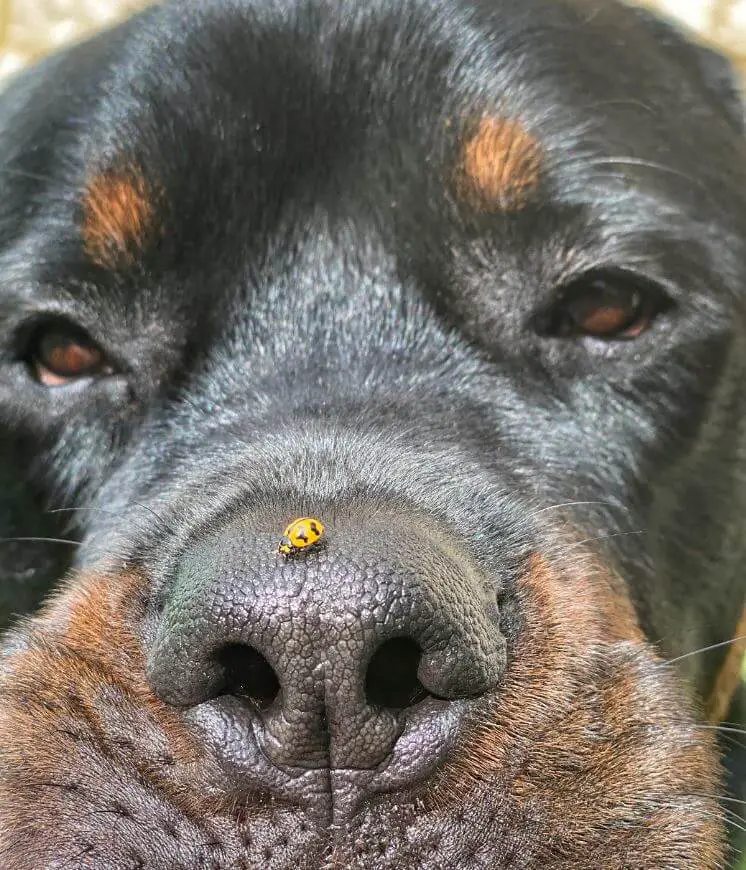Dogs have a natural curiosity and sometimes end up eating things they shouldn’t. Ladybugs, with their vibrant colors and small size, can catch a dog’s attention. While ladybugs are generally harmless to humans, you may wonder if they pose any risks to your furry companion. In this article, we will discuss what to do if your dog eats ladybugs, including potential risks and precautions to ensure your dog’s well-being.

Can Dogs Eat Ladybugs?
Ladybugs, also known as ladybirds or lady beetles, are not toxic to dogs. Ingesting a few ladybugs is unlikely to cause any major health issues for your pet. These insects do not contain harmful chemicals or toxins that could harm dogs.
However, it’s important to note that some ladybugs secrete a foul-tasting fluid called hemolymph when they feel threatened. If your dog consumes ladybugs that release this fluid, it may cause mild gastrointestinal upset, leading to symptoms such as drooling, vomiting, or diarrhea.
Risks Associated with Ladybug Consumption:
While ladybugs themselves are not toxic, there are a few considerations to keep in mind if your dog eats a significant number of them or shows signs of an adverse reaction:
- Choking Hazard: Ladybugs have a hard outer shell, which can pose a choking risk, especially if your dog swallows them whole without chewing.
- Allergic Reactions: In rare cases, dogs can develop an allergic reaction to ladybugs. Symptoms may include facial swelling, hives, difficulty breathing, or excessive itching. If your dog shows any of these signs, seek immediate veterinary attention.
- Pesticide Exposure: Ladybugs can be attracted to plants treated with pesticides. If your dog consumes ladybugs that have been in contact with these chemicals, it may lead to poisoning. Watch out for signs such as weakness, tremors, difficulty walking, or seizures, and seek veterinary assistance if you suspect pesticide exposure.

Steps to Take if Your Dog Eats Ladybugs:
If you catch your dog snacking on ladybugs, follow these steps to ensure their well-being:
- Monitor Your Dog: Keep a close eye on your dog for any unusual symptoms or behaviors. If your dog shows signs of distress, allergic reactions, or significant discomfort, contact your veterinarian immediately.
- Remove Ladybugs from Reach: If there are ladybugs in your immediate vicinity, try to prevent your dog from accessing them to avoid further ingestion.
- Provide Fresh Water: Offer your dog a bowl of fresh water to help dilute any potential irritants or toxins from the ladybugs.
- Assess Choking Risk: If your dog swallowed ladybugs without chewing, observe for any signs of choking. If your dog experiences difficulty breathing, excessive coughing, or distress, seek veterinary assistance promptly.
- Contact Your Veterinarian: If you have concerns about your dog’s health or if they exhibit abnormal symptoms after ingesting ladybugs, consult your veterinarian for professional guidance.
Preventing Ladybug Consumption:
To reduce the chances of your dog eating ladybugs in the future, consider the following precautions:
- Supervise Outdoor Activities: Keep a close eye on your dog while outdoors, especially in areas where ladybugs are prevalent, such as gardens or fields.
- Training and Recall: Teach your dog basic commands such as “leave it” or “drop it.” This will help redirect their attention and discourage them from eating ladybugs or other potentially harmful objects.
- Yard Maintenance: Regularly inspect your yard and remove any ladybug-attracting plants or treat them for infestations. This can help minimize the presence of ladybugs in your dog’s environment.

While ladybugs are generally harmless to dogs, it’s important to be aware of the potential risks associated with their consumption. If your dog eats ladybugs, monitor their behavior and watch for any signs of choking, allergic reactions, or pesticide exposure. Contact your veterinarian if you have any concerns or if your dog shows abnormal symptoms. By taking necessary precautions and seeking appropriate care, you can keep your furry friend safe and healthy, ensuring their well-being is always a top priority.
